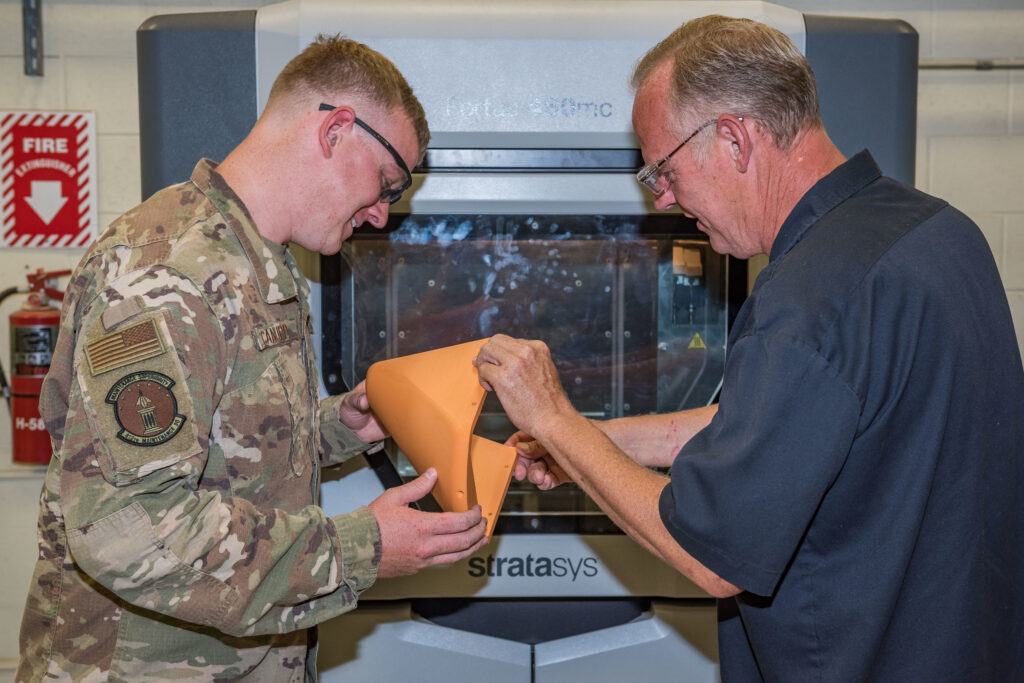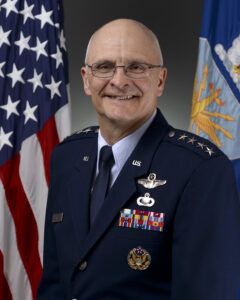
Staff Sgt. Cameron Canupp and Steven Conway, both of 412th Maintenance Squadron, visually inspect a part manufactured in a 3D printer at Edwards AFB in California.
WASHINGTON: Not a lot of money is at stake in the Air Force’s Advanced Manufacturing Olympics (AMO) competition in October, but the winners will secure ground-floor spots in the service’s high-priority drive to revolutionize aircraft maintenance.
Advanced manufacturing, including 3D printing, has the potential to “change the way we operate,” Lt. Gen. Robert McMurry, head of Air Force Life Cycle Management Center (AFLCMC), explained in a webinar today to preview the AMO technical challenges being held virtually Oct. 20-23. “It will make our operations more efficient; it’ll give us opportunities we never had,” he added.
McMurry is also the PEO for the Rapid Sustainment Office (RSO) that is sponsoring the “olympics,” which originally were to be held in St. Louis at the same time as the pandemic-canceled Tokyo Summer Olympics. Air Force Research Laboratory as well as America Makes, one of DoD’s eight manufacturing innovation institutes, are supporting the AMO.
Top service leaders — that McMurry jokingly called “old coots,” like himself — are increasingly convinced that advanced manufacturing (AM) will be a solution to the ever-growing problems and high costs of maintaining the service’s fleet of aging fighters and bombers, he said.
An October 2019 study by the Heritage Foundation showed the average age of Air Force aircraft to be 29 years. But some aircraft, particularly bombers, have been in the fleet much longer, kept flying by a series of expensive upgrades; i.e. the B-52 Stratofortress that was first introduced 68 years ago.
AM can not only reduce the cost of parts, but also facilitate the reverse engineering of parts now obsolete and difficult — if not impossible — to find. In addition, the ability to print parts on demand could dramatically reduce the time an aircraft spends in a hanger.
The bottom-line question that the Air Force hopes the “olympics” can help answer about AM processes, he added, is “how do we get to the ability to deliver flight critical hardware?”
Doing so is complicated because of the intensive and incredibly time-consuming process now required to certify 3-D printed parts due to uncertainties about the reliability of the materials produced via these novel methods.
“How do we build pieces and components that we are assured are certified safe for flight?” said McMurry. “Our rules and methods for determining safety of flight, the old saying is, they’re written in blood, because when we didn’t follow those rules, people died. So, how do we get confidence in the manufacturing capabilities of these new technologies, or build confidence-building measures around them to assure that we have safe components?”

Gen Arnold Bunch
Gen. Arnold Bunch, head of Air Materiel Command, said that 64 teams are competing in the AMO for a total of $1 million in prize winnings.
“We think this is an exciting time,” he said in a pre-recorded message during the webinar. “What we want to learn is how can we take this critical technology and support our ops. Can we forward deploy the technology, or can we use the technology to better support our forward deployed forces?”
Bunch also said he is interested in whether AM can help address the problem of “vanishing vendors,” either through reverse engineering by the service’s own maintenance staff or outside vendors.
The five AMO “challenges” are set up as competitions among teams from industry (including prime contractors such as Boeing and Lockheed Martin down to tiny startups), university researchers and even some airmen, via the SPARK Innovation Hub at Robins AFB in Georgia, Lily Arcusa, RSO chief technical officer, explained during the webinar. Judges, she explained, have been chosen from not just the Air Force, but also the Army, DoD and other government agencies, and industry.
Those challenges, each worth a top prize of $100,000, are:
- The Box of Parts Challenge. Teams will demonstrate the ability to scan and 3D print parts that have been reverse-engineered without a blueprint. The competitors will get their literal box of metal and polymer parts next Monday, Arcusa said, and will try to reproduce as many as possible.
- The F-16 Approval Sprint. Later this month, the teams will begin working on strategies to speed the flight safety approval process for F-16 parts, Arcusa said, with the end goal of actually developing a flight-worthy part that will be used on the current fleet.
- The Material Hurdles. Under this challenge, competitors will develop and produce new aluminum, polymer and hybrid (combination of both) materials for making AM parts, which will be judged on their strength and ease of use.
- The Supply Chain Marathon. Arcusa said competitors for this challenge to develop a strategy for increasing AM capacity and capabilities within the Air Force are actually nearing completion of the their tasks. She explained that the strategies need to address questions like how many 3D printing machines should the service buy and where should they locate them to maximize their efficient use? As Breaking D readers know, AFLCMC is buying 3D printers and teaching airmen to use them at selected depots.
- The Technical Data Package Challenge. Teams are competing to develop an easily shareable technical data package that allows materials printed on one type of 3D printer to be easily printed on another type in another location, Arcusa explained. Interestingly, one of the judges in this contest is from the Commerce Department National Institute of Standards and Technology (NIST), which certifies standards for US-made products and processes. As we reported, House appropriators back in May boosted NIST’s budget in part to help it move faster to set standards for emerging tech, including 3D printing.
In a ‘world first,’ DARPA project demonstrates AI dogfighting in real jet
“The potential for machine learning in aviation, whether military or civil, is enormous,” said Air Force Col. James Valpiani. “And these fundamental questions of how do we do it, how do we do it safely, how do we train them, are the questions that we are trying to get after.”


























